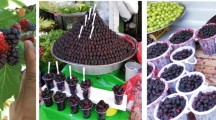Abstract
Mulberries are members of the genus Morus L., a taxonomic group showing a great genetic variability and adaptability to different environmental conditions. This study deals with the use of AFLP-based fingerprints as a tool for estimating genetic variability within as well as among three different mulberry species (i.e., M. alba L., M. latifolia Poir. and M. bombycis Koidz.). A high level of polymorphism (72.2) was found over all the 48 accessions analyzed. Genetic similarity (GS) within single Morus species ranged from 0.845 (M. bombycis) to 0.884 (M. alba) being intermediate in M. latifolia (0.869). The between-species mean genetic similarity estimates based on pair-wise AFLP marker fingerprint comparison were very similar ranging from 0.861 to 0.874. The partition of the genetic variation over the three Morus species was unexpected a proportion of the among-species genetic diversity as low as GST= 0.084 pointed out that about 92% of the total genetic diversity found among Morus accessions is due to DNA polymorphisms within a species, while only 8% of the total variation was highlighted among species. Our data indicate that some of the introduced accessions showing distinctive phenotypes, clearly differentiated from those revealed in the original habitat where they have been selected and adapted, hide an identical genotype.
Similar content being viewed by others
References
G. Barcaccia E. Albertini M. Falcinelli (1999) ArticleTitleAFLP fingerprinting in Pelargonium peltatum: its development and potential in cultivar identification J. Hort. Sci. Biotech. 74 243–250
Barcaccia G., Lucchin M. and Parrini P. (2003). Characterization of a flint maize (Zea mays var. indurata) Italian landrace: II. Genetic diversity and relatedness assessed by PCR-based markers. Genetic Resour. Crop. Evol. (in-press)
L.R. Dice (1945) ArticleTitleMeasures of the amount of ecological association between species Ecology 26 297–302
T.M. Fulton J. Chunwongse S.D. Tanksley (1995) ArticleTitleMicroprep protocol for extraction of DNA from tomato and other herbaceous plants Plant Mol. Biol. Rep. 13 207–209
M. Kimura J.F. Crow (1964) ArticleTitleThe number of alleles that can be maintained in a finite population Genetics 49 725–738
S.L. Krauss (2000) ArticleTitleAccurate gene diversity estimates from amplified fragment length polymorphism (AFLP) markers Mol. Ecol. 9 1241–1245
R.C. Lewontin (1974) The Genetic Basis of Evolutionary Change Columbia Univ. Press New York
M. Lynch B.G. Milligan (1994) ArticleTitleAnalysis of population genetic structure with RAPD markers Mol. Ecol. 3 1–20
Machii H., Koyama A. and Yamanouchi H. 2000. Mulberry breeding, cultivation and utilization in Japan. FAO Electronic conference on mulberry for animal production. http:// www.fao.org/livestock/agap/frg/mulberry/Papers/HTML/ma-chii2.htm.
J.M. McDermott B.A. McDonald (1993) ArticleTitleGene flow in plant pathosystems Annu. Rev. Phytopathol. 31 353–373
M. Nei (1973) ArticleTitleAnalysis of gene diversity in subdivided populations Proc. Natl. Acad. Sci. USA 70 3321–3323
M. Nei (1978) ArticleTitleEstimation of average heterozygosity and genetic distance from a small number of individuals Genetics 89 583–590
F.J. Rohlf (1972) ArticleTitleAn empirical comparison of three ordination techniques in numerical taxonomy Syst. Zool. 21 271–280
F.J. Rohlf (2002) NTSYSpc: Numerical Taxonomy System, ver. 2.1 Exeter Publishing, Ltd. Setauket, NY
N. Saitou M. Nei (1987) ArticleTitleThe neighbor-joining method: a new method for reconstructing phylogenetic trees Mol. Biol. Evol. 4 406–425
Sánchez M.D. (2000). World distribution and utilization of mulberry, potential for animal feeding. FAO Electronic conference on mulberry for animal production. http://www.fao.org/ livestock/agap/frg/mulberry/Papers/HTML/Intro.htm.
A. Sharma R. Sharma H. Machii (2000) ArticleTitleAssessment of genetic diversity in a Morus germplasm collection using fluorescence-based AFLP markers Theor. Appl. Genet. 101 1049–1055
P. Vos R. Hogers M. Bleeker M. Reijans T. Lee Particlevan de M. Hornes A. Frijters J. Pot J. Peleman M.E. Kuiper M. Zabeau (1995) ArticleTitleAFLPTM: a new technique for DNA fingerprinting Nucleic Acids Res. 23 4407–4414
F.C. Yeh R.C. Yang T. Boyle (1997) POPGENE Version 1.21 CIFOR and University of Alberta Edmonton, Alberta, Canada
Zabeau M. and Vos P. 1993. Selective restriction fragment amplification: a general method for DNA fingerprinting. European Patent Application 92402629.7
Author information
Authors and Affiliations
Corresponding author
Rights and permissions
About this article
Cite this article
Botton, A., Barcaccia, G., Cappellozza, S. et al. DNA fingerprinting sheds light on the origin of introduced mulberry (Morus spp.) accessions in Italy. Genet Resour Crop Evol 52, 181–192 (2005). https://doi.org/10.1007/s10722-003-4429-x
Received:
Accepted:
Issue Date:
DOI: https://doi.org/10.1007/s10722-003-4429-x




